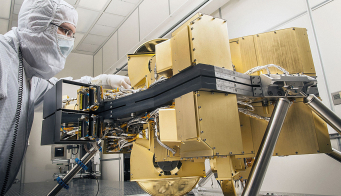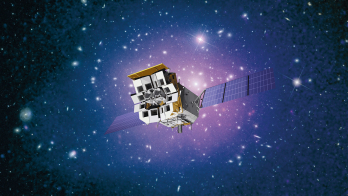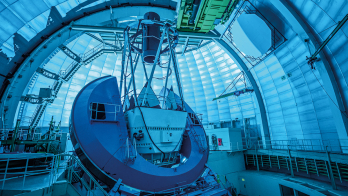
Image credit: NASA, JAXA.
After a spectacular launch from the Tanegashima Space Center on 19 August on board the Japanese H2-B rocket operated by the Japan Aerospace Exploration Agency (JAXA), the CALorimetric Electron Telescope (CALET) docked on the International Space Station on 24 August (EDT). From its privileged position at 400 km altitude, CALET will perform long-duration observations of high-energy charged particles and photons coming from space.
CALET is a space mission led by JAXA, with the participation of the Italian Space Agency and NASA. It is a CERN-recognised experiment and the second high-energy astroparticle experiment installed on the International Space Station (ISS) after AMS-02, which has been taking data since 2011. After berthing with the ISS, CALET was extracted by a robotic arm from the Japanese H-II transfer vehicle and installed on the external platform JEM-EF of the Japanese module. The instrument is now completing its check-out phase. Dedicated calibration runs will precede the start of the science data-taking period, which is expected to continue for several years.
CALET is a space observatory designed to identify electrons, nuclei and γ rays coming from space, and to measure their energies. A high-resolution measurement of the energy is provided by a deep, homogeneous calorimeter preceded by a high-granularity pre-shower calorimeter with imaging capabilities. To ensure very accurate calibration of the calorimetric instruments, the CALET collaboration has carried out several calibration tests at CERN, the most recent one in February 2015.
CALET’s science programme includes measurement of the detailed shape of the electron spectrum above 1 TeV. High-energy electrons are expected to originate less than a few thousand light-years from Earth, because they are known to lose energy quickly when travelling in space. Their detection might be able to reveal the presence of nearby astronomical source(s) where electrons are accelerated. The high end of the spectrum will be particularly interesting to scientists because it will help to resolve the interpretation of the electron and positron spectra reported by AMS-02, and could provide a clue to possible signatures of dark matter.
Thanks to its excellent energy resolution and ability to identify cosmic nuclei from hydrogen to beyond iron, CALET will also be able to study the hadronic component of cosmic rays. The collaboration will investigate the deviation from a pure power law that has been observed recently in the energy spectra of light nuclei, extending the present data to higher energies and measuring accurately the curvature of the spectrum as a function of energy. CALET will also measure the abundance ratio of secondary to primary nuclei, an important ingredient to understand cosmic-ray propagation in the Galaxy.








